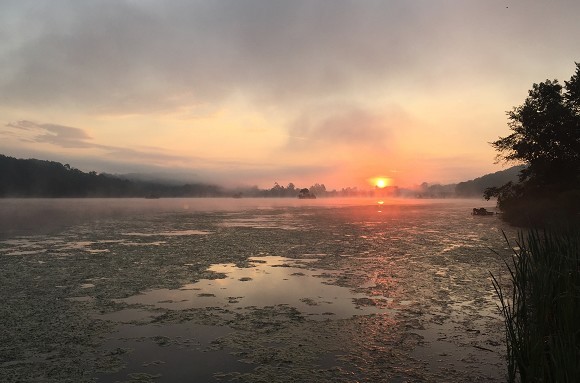
Carp Letter from America - August
Our bloggers in America, Simon Blanford and Andy Bell, tell us what they got up to in August...
After July’s successful three-day session on The Other Lake, August started quietly. Andy was ensconced at work and Simon became a temporary single parent while Mrs Simon went on a conference tour in the West. To make up for the lack of fishing Simon and the Miss Simons 1 and 2 did some carp related exploring on The Lake and The First Lake. These expeditions unfortunately ruled out promising looking areas rather than ruling them in. The Lake’s new spot was blanketed in impenetrable weed and The First Lake only revealed more small, emaciated carp.
But persistence is what’s vital under these circumstances and so we donned the foil helmets and stepped into the lead-lined underpants required for exploring the electronic netherworld. Reward was the discovery of three new spots of blue on Google maps, all close to each other, all within striking distance from home. With Andy snowed under by work, Simon made a round trip to take a look into the potential of each of these waters.
The first was gorgeous, the kind of lake we had been looking for. At just 30 acres it was, diminutive, reed-fringed, dotted with lily pads and wonderfully bucolic. It was also the exclusive preserve of a boat club. Patently ridiculous of course. What do boating types know about messing around on the water? The second lake looked promising on the map and internet reports confirmed it contained carp. But on arrival it was full of that pea green water suggestive of a place so full of carp that few are able to pack on any weight. Our experience of these waters is that they are prolific but it is difficult to find anything weighing in at more than six or seven pounds. The third water, at 140 acres was considerably smaller than our other stillwater venues. But it was gorgeous. Dotted with little islands the lake also had deep water at the dam and extensive shallows full of the silt dumped over time by the river entering at the lake’s head. From the bank it seemed only half the lake would be fishable, the shallow end being blanketed by an extensive algal bloom. But once the kayak had been sent skimming across the surface for a closer look it was apparent that the algae, though dense in many places, was patchy in others revealing occasional holes in the extensive subsurface weed beds.
Now we don’t often get to see our quarry. The kind of place we might get a glimpse, the shallow water in the bays and arms of the lakes we’ve fished, are mostly inaccessible to us bipedal bank fishers. We do see fish of course, leaping and crashing about over the deeper water but this doesn’t reveal anything of their more intimate behaviour. So far we haven’t had the classic view of fish ghosting between lily pads or the stalagmites of submerged weeds. And we haven't seen the glorious sight of a carp head down in the silt, its wafting tail crinkling the water surface.
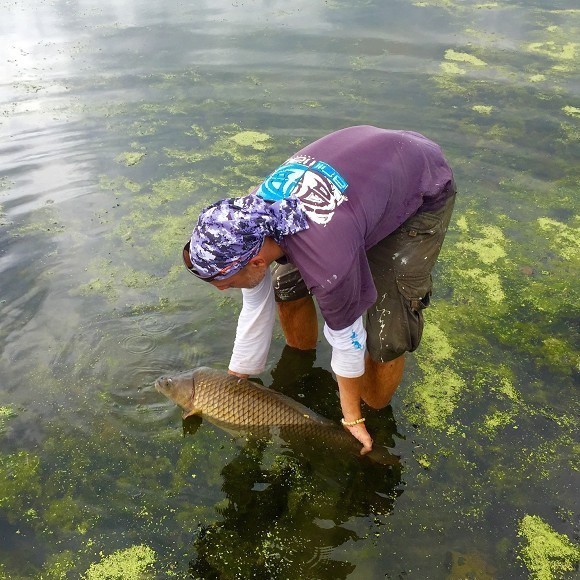
A Little Lake fish going back into its weedy home
Here on The Little Lake, as we called the place, carp were performing all these activities. They muddied and fizzed, they drifted through the scattered weed clumps, they sucked at the edges of the algal scum making the load smacking noise that is music to a carper’s ears. And every once in a while an individual would flollop heavily on the surface.
Simon apprised Andy of the situation and we slipped away early one morning to give it a go. The carp were still there flolloping and fizzing, muddying and mooching through the weedy shallows. Andy set up to target a small area clear of algae just short of an island. The subsurface weed looked patchy from twenty yards away but it turned out to be difficult to find any area clear enough to get a presentation that wasn’t directly into the green stuff. Obviously we’re going to have to get better at choosing and using rigs designed to help in the weeds but in the meantime Andy moved to join Simon presenting his baits in the weed-free line of the old creek channel. Carp, we surmised, would use this highway as an easy route to get about the place and if suitably enticed might stop off for a bit of grub along the way. The only immediate problem was that any hooked fish would have to be brought back through the accumulated algae that filled the space between the bank and the channel. Andy had a run almost straightaway but the fish got off. So did the next one. Neither loss was directly due to the weed though. There was a snag in the edge of the channel over which Andy was fishing and as soon as he had repositioned his baits he hooked and landed a lovely dark double.
A short while later he brought in a bigger eighteen pounder, a long, lean common typical of the carp here. He followed this with a smaller fish before things went a bit quiet for him. Simon, in the meantime, was having trouble. He lost his first, his second and his third fish. He lost his fourth too, all in snags that seemed to abound along the old creek edge irrespective of where he repositioned his bait. By midday the runs dried up for both of us under the increasingly hot sun. Fish were still moving here and there and some could clearly be seen amongst the weeds but none it seemed were willing to feed on our baits in the channel. We packed up having only sampled a small proportion of the potential of this Little Lake.
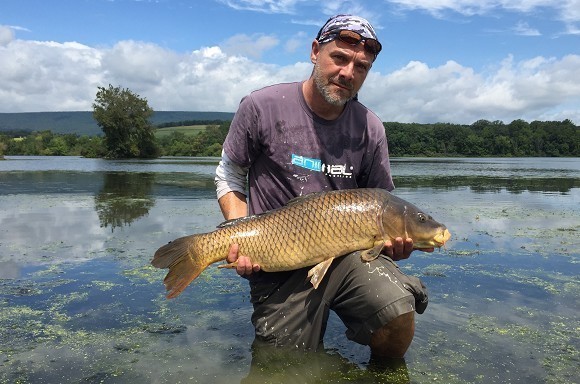
An eighteen pounder from The Little Lake
Labeling a water ‘little’ naturally depends on the sort of expanse you’re used to fishing. We’ve been in the States for approaching a decade and it’s certainly the case that our perception of a nice, intimate water has changed. This was brought home to us when we read amongst the CARPology articles and find that Rob Hughes describes Wraysbury South Lake as “a massive chunk of water” and in the August issue Jon McAllister also describing RDAA’s Sonning Pit as “massive”. Wraysbury South is 75 acres and Sonning 300 acres. They are large we suppose, Sonning especially so in comparison to Wraysbury South. But over here at least half the cliché about America is true. If the country is certainly not better, it is often bigger. Sonning may be large when compared to your Ashleas, your Redmires, Yateleys and the like, but it is small compared to what we have been fishing. The Lake for example is 1,600 acres and The First Lake (one we haven’t fished this season) is 1,700 acres. The Old Lake, from which Andy caught a 26 pounder a couple of years ago is 450 acres. But these waters are dwarfed by the one everyone tells us to go to and fish for carp. It’s only an hour down the road and covers nearly 8,000 acres. That puts it five times bigger than Grafham Water and two and a half times bigger than Rutland Water. It’s also deep, 200 feet in places, a consequence of damming a steep-sided valley. And it certainly does contain carp. You can feed them dog biscuits at the marina. You want carp? There they are.
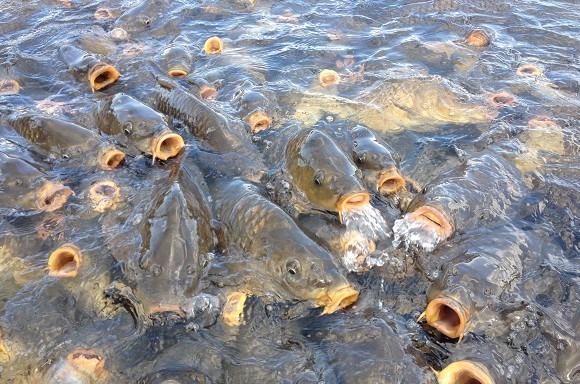
Gagging for it
Except you can’t. Fishing is prohibited in the marina. Quite right too. Fish in a barrel and all that. Andy has fished the lake, a couple of bays over from the carp crowd, catching so fast at times that he couldn’t keep more than one rod in the water. But none of them turned out to be the leviathans our local informants claimed we couldn’t fail to catch. Obviously they didn't allow for our consummate lack of skill. Or there are simply a great many double figure fish to get through before arriving at leviathan’s door.
Returning to the theme though. If we really want even more acreage we might also think of going back to a water we fished last season. Lake Seneca, north of here in New York State, is part of the conurbation of watery ribbons known as the Finger Lakes. Seneca is 43,000 acres which puts it more than twice the size of Loch Lomond. There are prodigious carp in it as witnessed by the gorgeously fat common Andy caught last spring as well as numerous reports in the local papers detailing what’s been landed (and subsequently ploughed into the land as fertiliser) during the area’s annual carp derby.
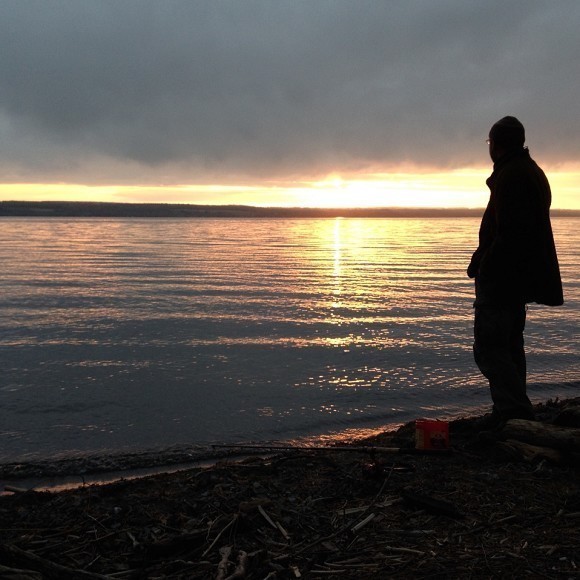
Where do you start? Andy contemplates Lake Seneca.
But even Seneca isn’t the largest of the lakes that is within reasonable range. There are of course, the Great Lakes and in particular Erie and Michigan (their size being too obvious to warrant exact description - just think Wales). They both hold carp and a regular stream of large fish get caught from their waters. And yes, by all accounts it is like fishing the sea. Certainly the expanse of water you look out on from behind your rod pods is considerably wider than the English Channel.
The rivers are not to be overlooked either. This area actually has a reputation for small trout streams. But the rivers in which one might reasonably look for carp are not at all diminutive. Our ‘little’ local river is hundreds of feet across. The Record River something similar where we fish it and The Big River (the one that produced the recent unofficial State Record and the one from which we have only managed catfish thus far) is, well, wide. Even Mr Fairbrass may struggle to cast somewhere near the other side and we’re buggered if we can even get halfway.
Of course there are small waters around. Farm ponds created by throwing an earth dam across a fold in the land and allowing it to fill with water. There are no carp in them. What farmer would stock a holding pond with trash fish?
No, in this neck of the woods carp fishing is invariably done in large lakes and rivers and when fishing these places there is always an awareness of the sheer volume of water that surrounds you - even when you have sequestered yourself up some quiet little sidearm. All that bait you prepared, which looked like a veritable mountain at home, now seems considerably less than a molehill when fed into all that wet stuff.
The best thing to do is ignore it. Ignore the cubic tons of water the fish might be swimming in, instead of the meagre gallons you are actually targeting - ignorance is blasé after all, or something like that - and bearing our own advice in mind we stuck to this tactic on our last trip of the month back at the Other Lake (a mere puddle at 700 acres).
We set up for a night session on the same arm of the lake we’d fished on our first visit last month. It was a dent in the shoreline we knew held fish and one that we could actually cast across (just about) with a few ounces of lead. But as we were setting up one of the ubiquitous dog walkers informed us of a problem with our chosen pitch. We would not be left in peace it would seem because the following morning, very early, a hoard of eager bass fishermen and their boats would descend on the lake for a day long tournament. The boat launch we were thinking of fishing next to was the designated meeting point and so our baits would be right under the accumulated horsepower and exhaust of all those boats as they sat waiting for the off. Simon, less than happy about the situation, suggested a wholesale change of venue. Andy, as practical as ever, proposed that we simply move to the other side of the boat launch, deeper into the arm and away from access to the main lake.
Which is what we did. Andy dropped his baits along a far bank weed bed while Simon hedged, picking the edge of some marginal lily pads and what looked like a nice turnaround point where the arm suddenly narrowed even more. Andy was into fish straightaway.
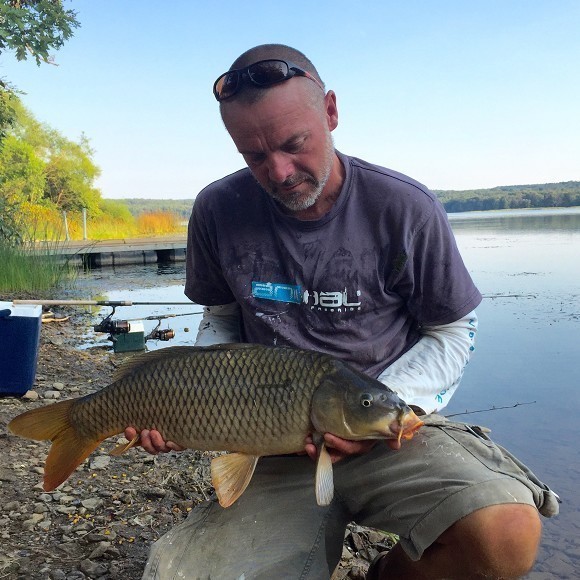
Andy lands his first
Simon wasn’t into fish straightaway.
But due to his inactivity he got to listen to another dog walker who had stopped behind Andy and was venting his opinion.
“F@#ck*&g hell, youse is carp fishing,” he said.
Now reproducing local vernacular is difficult. But in this case all you have to imagine is Toni Soprano, or one of his more ape-like New Jersey henchmen, talking about ‘wacking’ whoever has most recently caused offence.
Andy hadn’t heard the guy so the man repeated and embellished his original statement.
“Youse is carp fishing. F@ck me youse even got dose alarm things like dose English guys does.”
Andy finally paid attention, said hello politely and that yes, indeed, he was carp fishing.
“F@#k*&g hell, and youse English too!” He slapped his thigh as if the marvels of life could get no better. “I read about this f@#ck*&g stuff in a magazine. All that bolt and hair rigs and crap youse guys do in Engerland. And jeez youse is actually doin this stuff. F@#k*&g amazing.”
Happy to have pleased one of the locals Andy returned his attention to the rods and caught another fish.
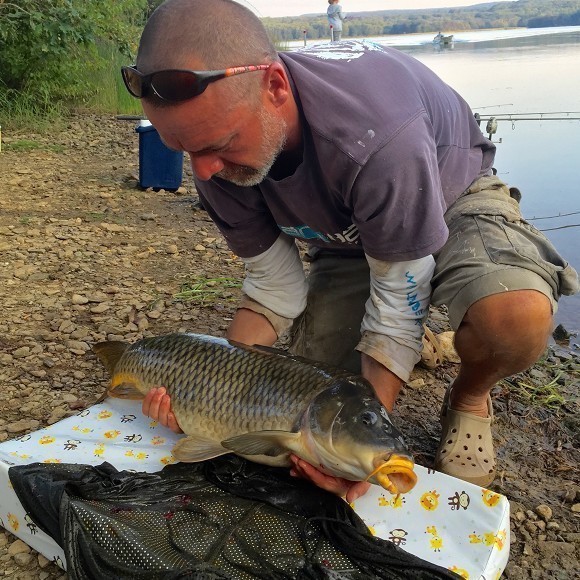
Andy lands another
Simon didn’t catch another fish.
Darkness fell, a bright full moon appeared and to the insistent whine of a thousand hungry mosquitoes we fell to discussing the weightier matters of the world. For example, what use are brightly coloured baits at night?
In the middle of this chat Andy caught yet another fish.
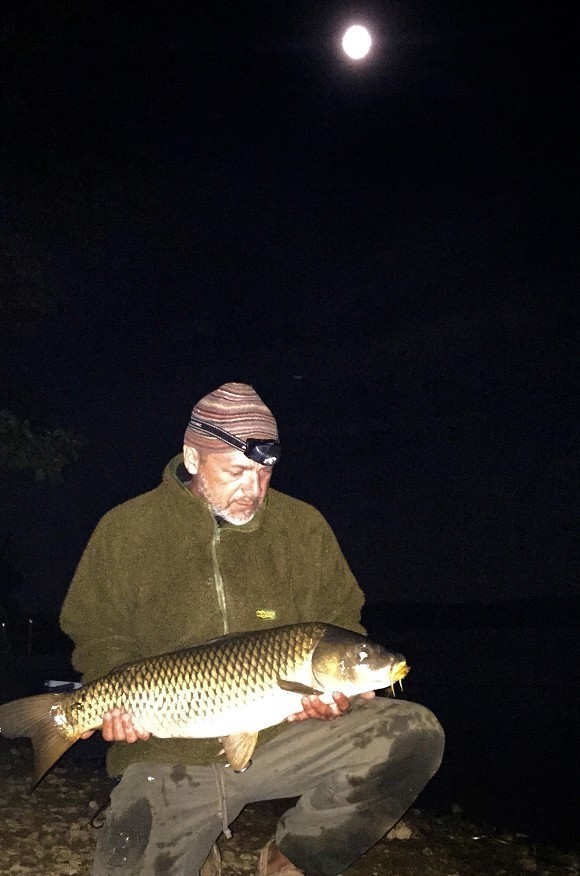
Andy lands yet another under the full moon
Simon didn’t catch yet another fish.
A carp’s vision, like other fish, is based on the vertebrate plan of cone and rod cells. Colour vision is enabled by various classes of cone cells. But these cone cells need a minimal level of light to work and are rapidly deactivated when light levels fall towards evening. The rod cells that take over visual perception at night don’t do colour – their role is to capture as much of the little light available as they possibly can. So a direct consequence of the deactivation of cone cells is that carp become colour blind at night. Just as we are.
Andy paused to catch another fish. The wrong kind of fish it has to be said, but a particularly chunky version of the wrong kind of fish.
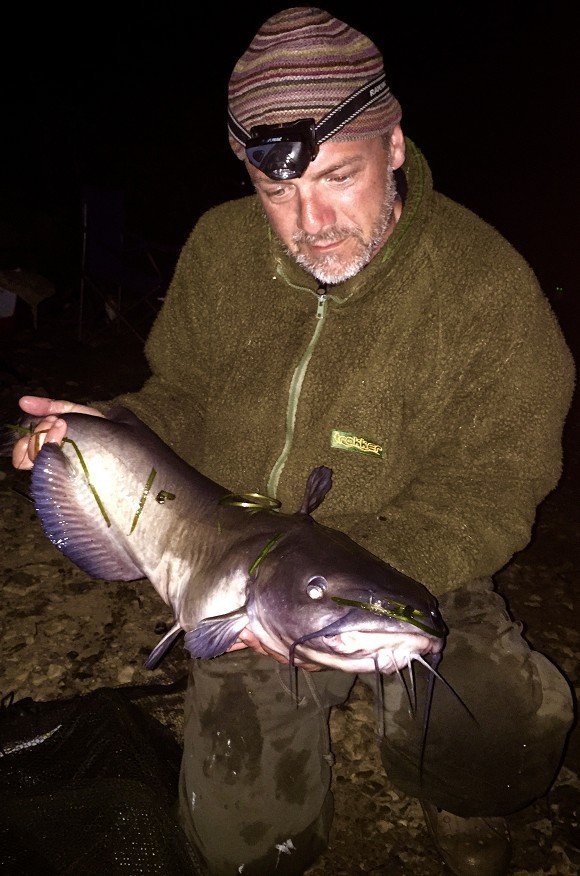
Andy lands the wrong kind of fish again. Very chunky but still wrong
Simon didn’t even get a sniff of the wrong kind of fish.
It makes us wonder what impact all those little snowmen actually have when sent to sit pertly off the bottom, nodding their bright little heads at the passing carp, in the dark. Or all those wafting, carefully washed-out balls, or even those vivid fluoro pop-ups. When everything to the carp is, at the very best, muted shades of grey and more likely just dark on dark after the sky-light goes out, what point is there to a deliberately coloured bait? Wouldn’t the contrast of a deeply black boilie work better? Perhaps Rob Hughes could add a dive to his excellent “Below the Surface” series and take some pictures of what baits and rigs look like at night. Take pictures without any lights of course – just as the carp would see them.
This topic satisfactorily polished off Simon, still fishless, changed his rig to a big feeder and fired it to the edge of Andy’s baited area. And promptly caught a fish.
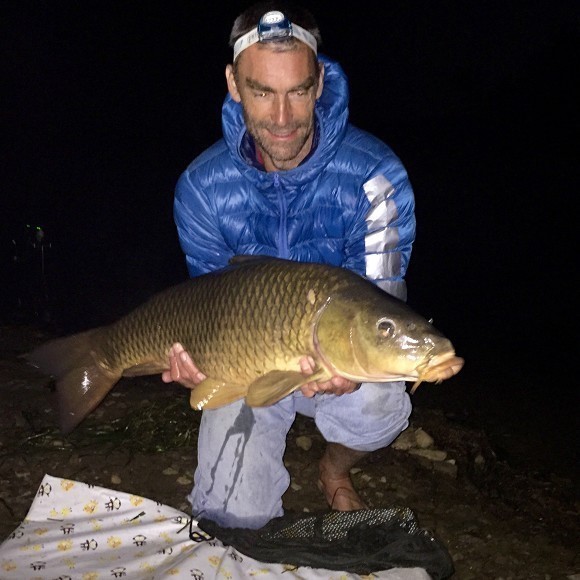
Simon resorted to stealing a fish from Andy’s swim
By now, four in the morning, the first of the bass competitors started to arrive. The boats and the fishermen they carried armed with their many, very short rods accumulated off the boat launch variously testing their engines to see just how many revs they could get away with. One parked over the top of Simon's right hand swim and despite protests stayed there. Simon threw most of his toys out of his pram and in a huff went off for a walk. Andy simply became more belligerent deploying his catapult and sending a regular stream of hardened bait balls in and around his area. On his return Simon suggested a move.
"The carp will be long gone with all this going on over their heads," he said.
In answer Andy's buzzer sounded and with studied nonchalance he hooked, played and netted a good double.
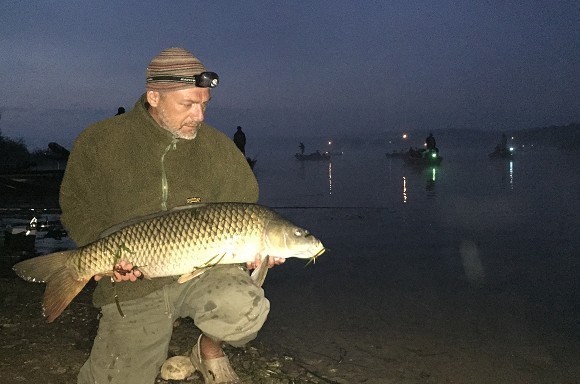
A fish from under the bass boats - never listen to Simon
"Ok, new rule of fishing," Simon remarked after the fish was back in the water. "Never listen to what Simon says.”
Once the bass boats had roared off we picked up two more fish, posed for a selfie and then packed up.
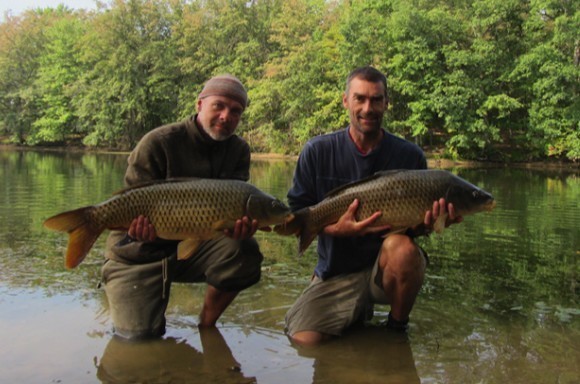
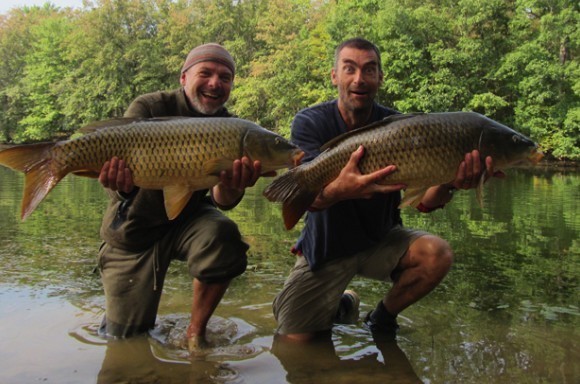
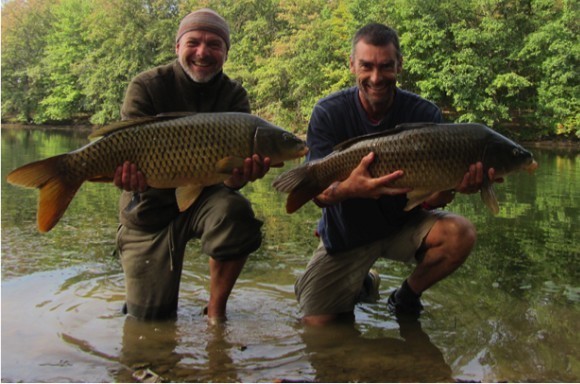
No, mine's bigger than yours
A good session though puzzling that one swim should be so productive whereas the other, at the most 15 yards away, was as quiet as the grave. Still, Andy had booked the cabin again next month for another multi-day session on this water and Simon finished his attempt to fill in The Lake with bird seed. Tune in to the next Carp Letter from America to find out how we did and discover just how intelligent American carp really are.




